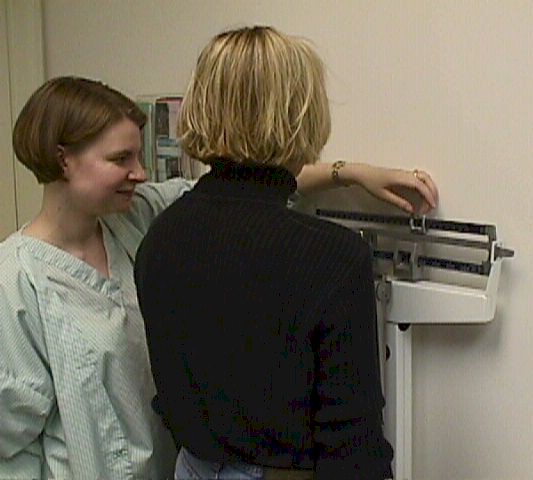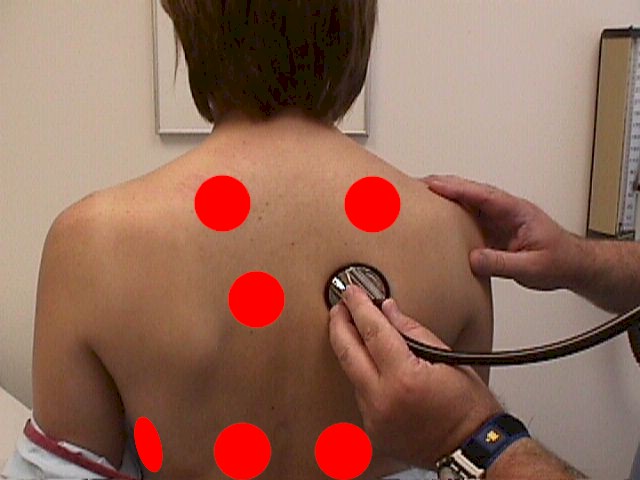|
Physical Exam
While some physicians perform each of these evaluations at every routine gynecologic
visit, some perform only those which focus on specific issues for the specific patient.
Weight
 Weigh the patient. Weigh the patient.
Make an assessment of how her weight fits with standards for good health. Too much and
too little weight are both problems.
Compare the weight with previous weights to assess the trend.
These ideal weight recommendations are the 1995 guidelines for weight vs height issued by the U.S.
Department of Health and Human Services, designed for both women and men.
These are best achieved through a normal balanced diet and moderate
exercise, lasting at least 30 minutes, most days of the week. Moderate
exercise necessarily elevates your resting heart rate and causes sweating.
An alternative assessment is the “Body Mass Index” which should ideally be
between 19 and 25. To measure BMI:
-
Multiply weight in pounds by .45. (Example: 150 pounds x .45 = 67.5)
-
Multiply height in inches by .025. (Example: 5’9”, or 69 inches, x .025
= 1.725.)
-
Square the answer from Step 2 (Example: 1.725 x 1.725 = 2.976).
-
Divide the answer from Step 1 by the answer from Step 3 (Example: 67.5
divided by 2.976 = BMI of 22.7).
Blood Pressure
Measure the blood pressure and the other vital signs.
Particularly among older women, elevated blood pressure is a common problem and one
that may be effectively controlled or treated. Uncontrolled hypertension is
associated with a number of serious medical consequences.
A single elevation of blood pressure is usually not significant,
particularly if the patient has some anxiety about being seen and
examined. Blood pressure that is persistently ≥ 140 (systolic) or ≥ 90 (diastolic) is
considered elevated.
About 90% of hypertension is "primary"
or "essential" hypertension. 5-10% is caused by chronic renal disease,
and only 1-2% is caused by a curable condition.
If hypertension is found, a basic
laboratory workup to identify underlying illness might include:
Treatment for persistently elevated BP
usually starts with life-style changes of increased physical activity
(if sedentary), weight loss (if overweight), relaxation (if stressed),
and reduction in dietary sodium. For those whose BP does not responding
to life-style changes, medication is usually prescribed. These could
include diuretics,
ACE inhibitors,
Calcium Channel blockers,
Beta
Blockers, Angiotensin II receptor blockers, or
alpha-1-adrenergicblockers.
 Face and Eyes Face and Eyes
Look in her eyes.
Watch they eyes for symmetry, proportion, focus, white sclerae, and movement. Look for
any facial muscle weakness appearing as a droop or asymmetry.
Eye movements should be coordinated. The ability to read a sentence with each eye
suggests intact ophthalmic, neurologic and higher brain function.
Facial muscles should have symmetry.
If she can read text off a page, you have confirmed the essential
elements of neurologic function related to vision.
For a more detailed
discussion of the eye exam, click here.
Ears
 Look in her ears. Look in her ears.
While not always necessary, a quick look in the ears will confirm pearly-white drums,
the absence of fluid behind the drum, clean canals and the absence of pain while pulling
on the external ear to straighten the canal.
Note any redness, drainage, or tenderness.
She should be able to hear your whispering voice or the ticking of
your watch.
For a more detailed
discussion of the ear exam, click here.
|
Thyroid
Check the thyroid gland.
Many gynecologists routinely feel the thyroid for enlargement, tenderness or lumps
which might suggest a thyroid nodule.
Thyroid disease is more common among women than men, and increases in
incidence with advancing age.
Some menstrual abnormalities are associated with thyroid dysfunction.
Many hypothyroid patients, for example, have
infrequent menstrual
periods in addition to their fatigue and cold intolerance. Hyperthyroid
patients are more likely to have
heavy, frequent menstrual cycles.
For a more detailed
discussion of the neck exam, click here.
Lungs
 Listen for wheezes suggesting asthma, diminished breath sounds, or fine
crackles, suggesting pneumonia or heart failure. Listen for wheezes suggesting asthma, diminished breath sounds, or fine
crackles, suggesting pneumonia or heart failure.
Some apparently abnormal sounds will clear if the patient coughs.
Listen alternately in mirror image areas from one side of the chest to the other.
Asymmetry in breath sounds will attract your attention.
For a more detailed
discussion of the lung exam, click here.
 Heart Heart
Note the regularity of the rhythm.
Listen over the aortic, pulmonic, tricuspic, and mitral valve areas for abnormal sounds such as
clicks or murmurs.
Any hyperdynamic state, such as pregnancy, leads to increased flow across the
heart valves and leads, in many patients, to soft flow murmurs that are not
ordinarily heard.
The commonness with which these murmurs are heard during pregnancy should not
lull the examiner into assuming all murmurs heard during pregnancy are innocent.
For a more detailed
discussion of the heart exam, click here.
Breasts
Inspect and palpate for lumps, masses,
tenderness, nipple discharge, or skin changes such as dimpling,
retraction or crusting.
Dominant masses need further
evaluation, sometimes with mammography, ultrasound and/or fine needle
aspiration.
Bilateral nipple discharge may
indicate hyperprolactinemia.
Unilateral nipple discharge, if bloody,
may be the presenting finding with an intraductal papilloma. Most breasts can
demonstrate a drop or two of clear to white or greenish fluid if the ducts are
stripped.
For a more detailed discussion of the breast exam,
click here.
 Abdomen Abdomen
It should be soft, and non-tender, with no masses. The liver may be just
barely palpable below the rib cage and should not be tender.
Have the patient take a deep breath
while you press your examining hand down beneath the ribs on her right side.
While she exhales, keep pressure on your hand. With her next deep breath, you
will feel the liver edge descend down to or just past the costal margin. If it
is tender, that suggests swelling or inflammation of the liver.
The gall bladder is normally not
tender, but if diseased, it may be.
For a more detailed discussion of the abdominal
exam, click here.
Go directly to the Pelvic Exam |